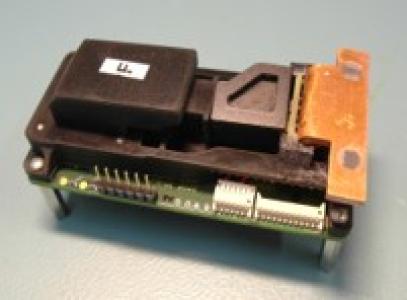Mini Fluorescence Microscope (MFM)

The objective of this activity is to assess the feasibility and to manufacture the smallest possible fluorescence microscope for space exploration, radiation, partial and micro-gravity related research.
Along 20 years of life sciences research in space, several full size microscopes were developed (phase contrast, fluorescence analysis, and recently the Advanced Light Microscope from NASA) to be used on board the ISS. However, such bulky systems appeared to prevent a versatile use and limit the potential of experiments that can be performed today on ground. In particular, none of them can be accommodated on an on board centrifuge to perform experiments in microgravity and at various G level. And for most of them, the samples are fixed on a glass slide and allow only static analyses. The Mini Fluorescence Microscope (MFM) shall reach the limits of miniaturization while providing the best possible performance for scientific analysis.Able to be integrated in the equivalent of a Type I container, an EMCS container or a Biolab experiment container shall be a top level requirement. It shall allow real time dynamic analysis on samples marked by potentially an unlimited array of fluorescent molecules, at different G levels. The study shall take into account the volume represented by a microfluidic system, which is either available already in the containers, or will have to be designed to present the samples to the microscope. The MFM would be extremely useful to help determining the threshold for gravisensing of living cells, and study the effects of the Moon and Mars Gravity on the intracellular mechanisms or the extracellular matrix between cells. This could also be a dedicated small instrument on board a rover for exploration mission to analyse at microscopic scale the samples to be harvested and give a primary characterisation of the samples.Today the commercial market proposes microscopes fitting on a mobile phone with very cheap production cost (less than 10 US$). However, they do not offer the capabilities of the MFM we would need. Hence, based on a rigorous trade-off, a technology development on a MFM that would address these aspects would be a breakthrough in this domain, dedicated for versatile use on board ISS, a cis-lunar station or an unmanned platform or even Cubesat.The domain of scientific applications for a MFM is diverse: Study of flux of proteins in cells resulting from radiation exposure, explore morphological changes in cells; cytoskeleton, membrane mechanosensitive channels or any other protein that can be tagged with a fluorescent molecule like e.g. GFP(green fluorescent protein) or YFP (Yellow Fluorescent Protein).Advanced fluorescent microscopy is also required by some experiment that are currently in the list of the ELIPS program. Microscopy was also identified in a review of the ELIPS program by the European Science Foundation (ESF) as a technology required for in-flight in-situ analyses. It is also one of the recommendations of the Science Space 3 roadmap. The MFM could be the tool for foreseen experiments like FLUOLIVE.The activity encompasses the following tasks :- to evaluate the feasibility, - to design the smallest possible fluorescence microscope.- to manafucture and charactersize a breadboard
